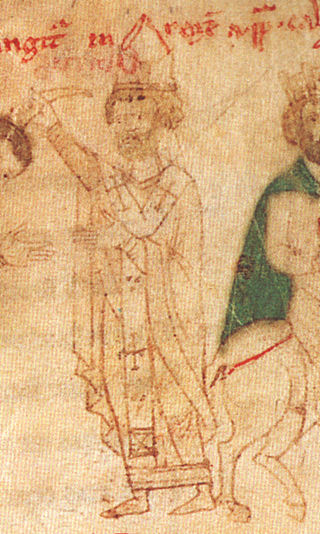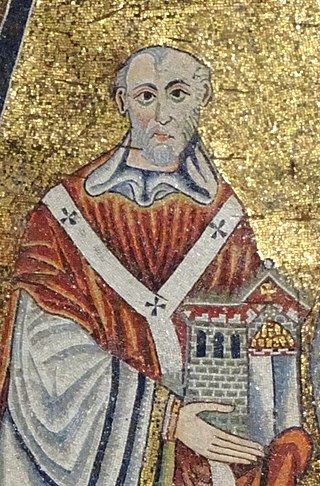Related Research Articles
An antipope is a person who claims to be Bishop of Rome and leader of the Catholic Church in opposition to the legitimately elected pope. Between the 3rd and mid-15th centuries, antipopes were supported by factions within the Church itself and secular rulers.

Pope Honorius II, born Lamberto Scannabecchi, was head of the Catholic Church and ruler of the Papal States from 21 December 1124 to his death in 1130.

Pope Callixtus II or Callistus II, born Guy of Burgundy, was head of the Catholic Church and ruler of the Papal States from 1 February 1119 to his death in 1124. His pontificate was shaped by the Investiture Controversy, which he was able to settle through the Concordat of Worms in 1122.

Pope Innocent II, born Gregorio Papareschi, was head of the Catholic Church and ruler of the Papal States from 14 February 1130 to his death in 1143. His election as pope was controversial and the first eight years of his reign were marked by a struggle for recognition against the supporters of Anacletus II. He reached an understanding with King Lothair III of Germany who supported him against Anacletus and whom he crowned as Holy Roman emperor. Innocent went on to preside over the Second Lateran council.

Pope Gelasius II, born Giovanni Caetani or Giovanni da Gaeta, was head of the Catholic Church and ruler of the Papal States from 24 January 1118 to his death in 1119. A monk of Monte Cassino and chancellor of Pope Paschal II, Caetani was unanimously elected to succeed him. In doing so, he also inherited the conflict with Emperor Henry V over investiture. Gelasius spent a good part of his brief papacy in exile.

Pope Lucius II, born Gherardo Caccianemici dal Orso, was head of the Catholic Church and ruler of the Papal States from 9 March 1144 to his death in 1145. His pontificate was notable for the unrest in Rome associated with the Commune of Rome and its attempts to wrest control of the city from the papacy. He supported Empress Matilda's claim to England in the Anarchy, and had a tense relationship with King Roger II of Sicily.
Anacletus II, born Pietro Pierleoni, was an antipope who ruled in opposition to Pope Innocent II from 1130 until his death in 1138. After the death of Pope Honorius II, the college of cardinals was divided over his successor. Unusually, the election was entrusted to eight cardinals, who elected Papareschi. A larger body of cardinals then elected Pierleoni, which led to a major schism in the Roman Catholic Church. Anacletus had the support of most Romans, including the Frangipani family, and Innocent was forced to flee to France. North of the Alps, Innocent gained the crucial support of the major religious orders, in particular Bernard of Clairvaux's Cistercians, the Abbot of Cluny Peter the Venerable; and Norbert of Xanten, the Archbishop of Magdeburg who established the Premonstratensians and held a high rank in the court of the German Emperor Lothar III.
The family of the Pierleoni, meaning "sons of Peter Leo", was a great Roman patrician clan of the Middle Ages, headquartered in a tower house in the quarter of Trastevere that was home to a larger number of Roman Jews. The heads of the family often bore the title consul Romanorum, or "Consul of the Romans," in the early days.
Pandulf of Pisa was a twelfth-century Italian cardinal, and biographer of several contemporary popes. He was a native of Rome. He was a nephew of Cardinal Hugo of Alatri. Under Pope Paschal II, and probably with the patronage of his uncle, Pandulf held the post of ostiarius at the papal court. It is deduced from his detailed description of the election of Pope Gelasius II on 24 January 1118 that he was present. On his coronation day, 10 March 1118, Pope Gelasius II elevated him to the rank of Lector and Exorcist. Pope Calixtus II ordained him a subdeacon.

The 1130 papal election was convoked after the death of Pope Honorius II and resulted in a double election. Part of the cardinals, led by Cardinal-Chancellor Aymeric de la Chatre, elected Gregorio Papareschi as Pope Innocent II, but the rest of them refused to recognize him and elected Cardinal Pietro Pierleoni, who took the name of Anacletus II. Although Anacletus had the support of the majority of the cardinals, the Catholic Church considers Innocent II as the legitimate Pope, and Anacletus II as Antipope.
Pietro Senex was Cardinal-Bishop of Porto from 1102 until his death. He was born probably in Rome.
The 1124 papal election took place after the death of Pope Callixtus II on 13 December 1124. The election was characterised by a power struggle between Italian cardinals supported by the Pierleoni family and northern cardinals supported by the Frangipani family. On 16 December the cardinals elected Theobaldo Boccapecci, the cardinal-priest of Sant'Anastasia. He chose the name Celestine II. Before his consecration, however, an armed party of the Frangipani attacked and wounded the newly elected pope. In the following confusion the Bishop of Ostia Lamberto Scannabecchi, the Frangipani's candidate was proclaimed pope under the name Honorius II. After several days of factional fighting Celestine was abandoned by his supporters. However, Honorius would not accept the throne in this manner and resigned as well. He was immediately re-elected and consecrated on 21 December 1124.

The 1118 Papal Election was held to choose the successor for Pope Paschal II, who died in Rome on 21 January 1118, after an 18-year pontificate. Pope Gelasius II was elected as his successor. The election happened during the Investiture Controversy, a conflict between supporters of the Papacy and those of the Holy Roman Emperor. The election was held under the threat of possible violence due to the controversy. The Cardinal electors took refuge in the Benedictine monastery, S. Maria in Pallara, during the election. Within minutes of his election as pope, Gelasius II was attacked and imprisoned by the Frangipani faction, supporters of the Holy Roman Emperor. Gelasius managed to escape, but at the emperor's arrival with his army, he fled Rome and never returned.
Vitalis of Albano was a Cardinal and bishop of Albano.
Petrus Pisanus was a Roman Catholic Cardinal. He began his career in papal service as a scriptor in the chancellery. He was appointed Deacon of San Giorgio in Velabro, and then promoted Cardinal-priest of Santa Susanna. He served briefly as papal legate in Corsica, before becoming a permanent member of the papal court. He participated in the papal elections of 1118, 1124, and 1130. In 1130, he chose to support the Obedience of Anacletus II rather than that of Innocent II. After Anacletus died in 1138, he joined the Obedience of Innocent II, and survived the purge of 1139.
Bonifacius was a Roman Catholic Cardinal and Cardinal-priest of the titulus of San Marco. In 1111, he was one of the cardinals captured by King Henry V at what was supposed to be his coronation, and was held prisoner near Rome along with the pope for sixty-one days. He was forced to subscribe to the oath taken by Pope Paschal II, according to the dictates of King Henry. He was then one of the cardinals who opposed the agreements struck by Paschal with Henry in the Lateran synod of 1112. He was not one of the cardinals who followed popes Gelasius, Calixtus, or Honorius on their travels. In the contested papal election of 1130, he supported Pope Anacletus II.
Desiderius was a Roman Catholic Cardinal, and Cardinal-priest of the titulus of S. Prassede in Rome.
Benedictus was a Roman Catholic Cardinal, and Cardinal-priest of the titulus of San Pietro in Vincoli in Rome, also called the titulus Eudoxiae.
Saxo de Anagnia was a Roman Catholic Cardinal, and Cardinal-priest of the titulus of S. Stefano al Monte Celio in Rome. He was a native of Anagni, and a member of the family of the Conti di Anagni. Dumas points out that there is no positive evidence of the family connection.
Jonathan was a Roman Catholic cardinal who played a major role in two divisive papal elections.
References
- ↑ His family, the Buccapecorini, are mentioned among the families who came to the rescue of the newly elected Pope Gelasius II in January 1118, according to Pandulf of Pisa in his "Life of Gelasius II", in J.B.M. Watterich, (1862), Pontificum Romanorum qui fuerunt inde ab exeunte saeculo IX usque ad finem saeculi XIII vitae: ab aequalibus conscriptae(in Latin) Tom. II (Leipzig: G. Engelmann), p. 96.
- 1 2 3 Kelly, J. N. D., and Walsh, Michael J., eds. "Celestine (d. 1124)". A Dictionary of Popes, 2nd ed. Oxford University Press. ISBN 9780199295814 [ page needed ]
- 1 2 Pham, John-Peter (2004). Heirs of the Fisherman: Behind the Scenes of Papal Death and Succession. Oxford University Press. ISBN 9780199334827 [ page needed ]
- ↑ Levillain, Philippe (2002). The Papacy: An Encyclopedia, Vol II: Gaius-Proxies. Routledge. [ page needed ]
- ↑ Mann, Horace K. (1925). The Lives of the Popes in the Middle Ages, Vol 8, p. 232
- ↑ Ott, Michael (1910). "Pope Honorius II". The Catholic Encyclopedia. Vol. 7. New York: Robert Appleton Company. Accessed 1 August 2021.
 This article incorporates text from this source, which is in the public domain .
This article incorporates text from this source, which is in the public domain . - ↑ Kelly's comment is pure conjecture. There is no evidence as to the fate of Teobaldo after his resignation, according to Rudolf Hüls (1977). Kardinäle, Klerus und Kirchen Roms: 1049–1130(in German), Bibliothek des Deutschen Historischen Instituts in Rom. ISBN 978-3-484-80071-7. p. 149.
- ↑ Miranda, Salvador. "BOCCAPECORA, Teobaldo (?-?)". The Cardinals of the Holy Roman Church. Florida International University. OCLC 53276621.